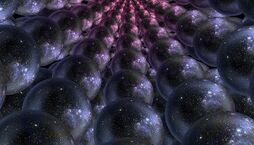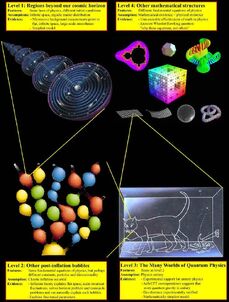No edit summary Tag: Visual edit |
(→About) Tag: Visual edit |
||
| Line 11: | Line 11: | ||
There can even be multiverses with different properties within the [[Megaverse]]. |
There can even be multiverses with different properties within the [[Megaverse]]. |
||
| − | == ''' |
+ | == '''Information''' == |
There are different ideas of what a multiverse is, but the basic idea is alternate versions of our own reality and put on an infinite or finite level. However, the structure of the multiverse, the nature of each universe within it, and the relationships among these universes differ from one multiverse hypothesis to another. |
There are different ideas of what a multiverse is, but the basic idea is alternate versions of our own reality and put on an infinite or finite level. However, the structure of the multiverse, the nature of each universe within it, and the relationships among these universes differ from one multiverse hypothesis to another. |
||
| − | |||
| − | The term was coined by physicist William James.<ref group="Wikipedia">https://en.wikipedia.org/wiki/Multiverse</ref> |
||
== '''Dimensionality''' == |
== '''Dimensionality''' == |
||
Revision as of 22:48, 18 February 2018
A multiverse is a self-contained group, or larger bubble filled with a finite or infinite number of universes. In many cases, the term is used to define, or larger bubble filled with a finite or infinite number of universes. In many cases, the term is used to define the hypothetical set of every single possible universe, including the universe in which we live.
The various universes within the multiverse are called "parallel universes", "other universes", or "alternative universes". It is possible to classify a multiverse based on what types of universes it contains and how they relate to each other as shown on the Altverse page.
There can even be multiverses with different properties within the Megaverse.
Information
There are different ideas of what a multiverse is, but the basic idea is alternate versions of our own reality and put on an infinite or finite level. However, the structure of the multiverse, the nature of each universe within it, and the relationships among these universes differ from one multiverse hypothesis to another.
Dimensionality
The dimensionality of a multiverse depends on the specific interpretation of the multiverse taken.
The simplest conception of a multiverse is five dimensional, with several four dimensional universe-lines arranged in a stack in the fifth dimension. (An alternative, even simpler thought is that they are actually four-dimensional like our universe; universes within would just have three-dimensional spacial boundaries like bubbles.)
Imagining the Tenth Dimension conceives them as being six dimensional, with the fifth and sixth dimensions representing different directions that a timeline can be diverted to create alternate universes.

Bubbles of spacetime
The most extreme conception of the multiverse has them be infinite dimensional, with the coordinates of a point in the multiverse representing the complete state of the universe located at that position (such a multiverse can also be called a phaseverse).
Mark Tegmark's 4 Levels of the Multiverse

The cosmologist Max Tegmark has come up with 4 possible interpretations of how the multiverse might be structured, which we now call Tegmark's 4 levels of the multiverse.
Level 1
This interpretation proposes that the universe infinite and ergodic, containing an infinite number of Hubble Volumes with an infinite number of possibilities in total. Due to the infinite multitude of Hubble Volumes at a certain point Hubble volumes start repeating themselves; this means according to this interpretation of the multiverse that if you travel far enough eventually you'll meet yourself.
Level 2
According to this interpretation the universe expands forever with some regions of the infinite space splitting off from the whole, forming what we call universes.
Level 3
According to this interpretation of the multiverse every choice we make creates a split in space and time, creating an entirely separate universe.
Level 4
The final level of the multiverse represents Tegmark's idea that the multiverse consists of all possible permutations of mathematics. With an infinite number of natural laws existing across the uncountably infinite set of universes.
Multiverse Vs. Omniverse
Really, it's all about terminology. However, you can define a/the Multiverse can be a way to describe the Omniverse as well. One could say the very prefix 'Omni' (All) could put the Omniverse above Multiversal level, say the Multiverse contains 'Multiple' realities but not exactly 'all'.
Think about it this way: There are several Multiverses in fiction, such as Marvel, Doctor Who, DC, Rick and Morty, Saint Seiya, Lego, Futurama, Kingdom Hearts, Half-Life, Dark Tower, whatever. They are all brought together within the Omniverse, containing all fiction and non-fiction. In other words, they're bound by copyright and stick to their own continuity and only occasionally interact, meaning each Multiverse is their own 'everything' or 'reality'.
For Megaverse, the concept itself is just a way to help keep a separation between the Omniverse and Multiverse, for whatever concepts may be outside the very concept of a Multiverse or perhaps just a standalone Universe.
Relax, this isn't any Hyperrealist statement or anything, just explaining fiction and it's affect on the Multiverse/Omniverse concept, we know the difference between fiction and non-fiction.
See Also
| Nested Level | 1st | 2nd | 3rd | 4th | 5th | 6th | 7th | 8th | 9th | 10th | 11th | 12th | ... | ωth | (ω+1)st | (ω+2)nd | (ω+3)rd | (ω+4)th | ... | (ω·2)nd | ... | th |
|---|---|---|---|---|---|---|---|---|---|---|---|---|---|---|---|---|---|---|---|---|---|---|
| Archverse | Universe | Multiverse | Megaverse | Gigaverse | Teraverse | Petaverse | Exaverse | Zettaverse | Yottaverse | Ronnaverse | Quettaverse | Vendekaverse | ... | Omniverse | Monocosm | Beyond | Transcendentem | Transcendentem Continuum | ... | Secode | ... | Ordverse |

